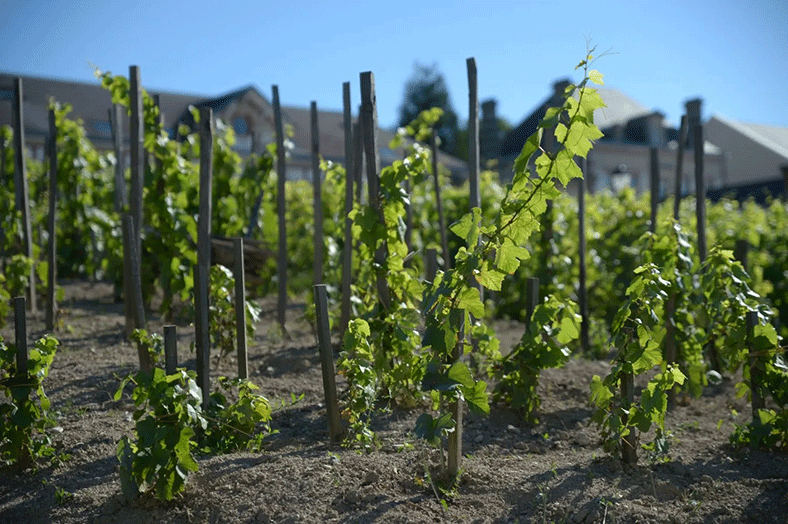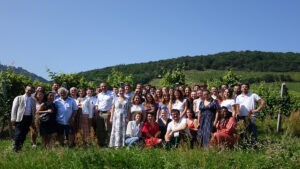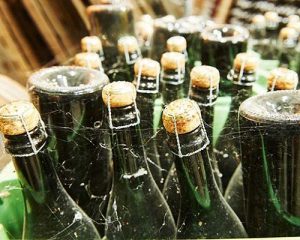
You have surely heard some winemakers, or read some articles, talk about wines made from “non-grafted vines”. This term, which seems rather highbrow, has a rather specific meaning for the quality of the wine produced, so we’ re going to take a closer look.
The story of franc de pied vines
To understand this expression, we need to take a trip back in time and remember that during the second half of the 19th century, phylloxera – a minute American louse accidentally introduced into Europe – was laying waste to the vineyards of France. It attacked the roots, digging a host of tiny tunnels and killing all the vinestocks. The result was a genuine economic and human catastrophe on a scale which is hard to comprehend today (for example, 2.5 million hectares destroyed in 30 years). In the absence of an effective physical or chemical treatment, the only viable solution was inspired by the observations of various French and American specialists who had noted the resistance of vinestocks from across the Atlantic. They therefore decided to graft vines from different French regions onto American rootstocks, whose roots were immune to the attacks of the devastating parasite. It was an effective decision, but one whose effects on the taste of the wine were not fully appreciated at the time. Even a non-specialist might speculate that the rootstock could act as a sort of “filter” between the soil and the grape, and that this role – in replacing the previous direct link – might not be an entirely neutral one.
 However, as in the adventures of Asterix… nearly all of Gaule had been colonised by American rootstocks… and yet a small band of indomitable Gauls still held out!
However, as in the adventures of Asterix… nearly all of Gaule had been colonised by American rootstocks… and yet a small band of indomitable Gauls still held out!
Very old, pre-phylloxera vines
Firstly, there are a number of very old vinestocks dotted around certain (small) parcels which derive from very old pre-phylloxera vines. These vines are thus nearly 150 years old, or even approaching 200 years in some cases. Those of Bollinger, in Champagne, spring to mind. These vines produce a Vieilles Vignes Françaises wine from non-grafted Pinot Noir vines which were spared by phylloxera. In south-western France, the Piedmont vines of the Pyrenees region near Sarragachies in the Gers département (also known as the Vigne de la Ferme Pédebernade) are some of France’s oldest vines, with vinestocks thought to date back to the early 1820s, i.e. nearly 200 years old. Located in the heart of the Côtes-de-Saint-Mont appellation, they feature non-grafted varieties which were not affected by phylloxera. Indeed, these vines were even awarded the status of Historic Monuments in 2012!
In the Camargue region, where much of the soil is composed of sand carried by the wind and sea, vine stocks were not ravaged by phylloxera. Taking advantage of this exceptional location, the Domaine de Vassal in Marseillan is home to the INRA’s Conservatoire mondial des ressources génétiques de la vigne vine bank. Unique of its kind in the world, it is a collection of 2,250 varieties which plays a key role in maintaining the genetic heritage of vines around the globe.

Vineyard replanted with non-grafted vines
However, such venerable vines are very much the exception to the rule. Far more common are vines planted 20 or 30 years ago by growers intrigued by the potential of such franc de pied vines (the expression indicates that they have not been grafted onto American rootstocks, and are therefore similar to the same pre-phylloxera varieties). Where available, these growers choose very sandy parcels, as this soil type is fairly effective at preventing the famous louse from attacking the roots. A number of growers from the Loire – including the pioneer Henry Marionnet – have adopted this strategy, with varying degrees of success. Although the Domaine de La Charmoise (Marionnet) produces Gamay, Malbec, Chenin and Sauvignon wines every year from its large, sandy vineyards, others – such as the Charles Joguet and Bernard Baudry estates in Chinon, the Domaine des Roches Neuves in Saumur-Champigny, the Domaine Breton in Bourgueil and the Domaine François Chidaine in Montlouis – have run into problems, with their ungrafted vines sometimes being hit by phylloxera after only ten years or so of growth.
Some growers from other regions of France have also tried the same approach, despite its risks and difficulties. It should also be noted in passing that certain foreign wine regions were never affected by the notorious parasite, and can thus boast an almost complete complement of non-grafted vines; such as, for example, the island of Santorini in Greece (famous for its magnificent white wines), the island of Cyprus and, in South America, the country of Chile.
Wines from ungrafted rootstocks: better, or just different?
It isn’t every day you have the chance to compare wines from grafted and non-grafted vines. This is firstly because only a few hectares of non-grafted vines remain in France. Secondly, the wines should ideally be produced from identical parcels. And lastly, with the exception of the (increasingly rare) wines produced from authentic pre-phylloxera vines, wines from non-grafted vines are generally produced from very young vines (around 10-20 years old), which compare unfavourably with wines from the same estate produced from mature vines (aged at least 30 years). However, the efforts of a number of Loire growers in particular provide us with a fairly shrewd idea of how these wines taste. And their characteristics have been unearthed through a number of tastings.
Experts who have attended such tastings are mainly in agreement: wines from non-grafted rootstocks are genuinely different – especially in terms of how they feel in the mouth – and most tasters rate them as better.
The majority of comments feature descriptions such as “silky texture”, “harmony”, “freshness” and “great balance”, with tasters frequently referring to a very direct contact with the wine, a characteristic which makes it irresistible to drink: it “flows on its own.” Most describe finer, “lacier”, delicate aromas which are never over-exuberant. Overall, there is a perception that the grapes are riper, and although no more powerful, are still fuller and more complete in terms of maturity. This is true regardless of grape variety.
Growers emphasise the “filtering” role played by the rootstock, and especially by the scar invariably left by the actual graft onto the plant. And they note in passing that most modern, mechanised grafts have played a significant role in increasing this filtering effect by creating poor-quality “joins”.
The grafted vine also depends on whatever nutrients the rootstock can obtain from the soil. And this rootstock is programmed by nature to satisfy only the needs of its own physiology, rather than those of the grafted vine. Of course, the same can’t be said of a non-grafted vine…
This arranged marriage inevitably affects the physical/chemical balance of the grafted vine, and therefore its quality, vitality and longevity. In some cases the match can be a happy one, but sometimes – as in any marriage – things don’t work out so well…
Maybe it’s nostalgia which prompts some to opine that these wines taste like the wines of yesteryear. It’s a lovely thought, but completely unverifiable… since obviously those tasters can’t ever have sampled a pre-1850 wine! Indeed, it’s highly likely that the ancient wines would suffer from such a comparison, given that wine-making practices as regards vines, harvesting and cellars (to say nothing of technology) have changed considerably, and most likely raised average wine quality. What is beyond doubt, however, is that these wines from non-grafted vines are markedly different from their half-siblings produced from grafted vines (other factors such as variety, grower and terroir being equal) and that for many tasters, they probably do afford a little extra pleasure.
Lookup a price estimate for a wine



